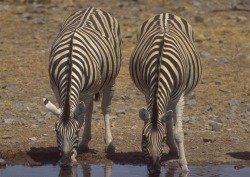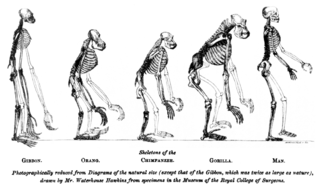
Gekkonidae is the largest family of geckos, containing over 950 described species in 61 genera. Many "typical" geckos are members of Gekkonidae, including house geckos (Hemidactylus), tokay geckos, and day geckos (Phelsuma). Gekkonid geckos occur globally and are particularly species-rich in tropical areas.

Hypsogastropoda is a clade containing marine gastropods within the clade Caenogastropoda.

Eureptilia is one of the two major clades of the Sauropsida, the other being Parareptilia. Eureptilia includes not only all Diapsids, but also a number of primitive Permo-Carboniferous forms previously classified under the Anapsida, in the old order "Cotylosauria".

The eudicots, Eudicotidae or eudicotyledons are a clade of flowering plants that had been called tricolpates or non-magnoliid dicots by previous authors. The botanical terms were introduced in 1991 by evolutionary botanist James A. Doyle and paleobotanist Carol L. Hotton to emphasize the later evolutionary divergence of tricolpate dicots from earlier, less specialized, dicots. The close relationships among flowering plants with tricolpate pollen grains was initially seen in morphological studies of shared derived characters. These plants have a distinct trait in their pollen grains of exhibiting three colpi or grooves paralleling the polar axis. Later molecular evidence confirmed the genetic basis for the evolutionary relationships among flowering plants with tricolpate pollen grains and dicotyledonous traits. The term means "true dicotyledons", as it contains the majority of plants that have been considered dicots and have characteristics of the dicots. The term "eudicots" has subsequently been widely adopted in botany to refer to one of the two largest clades of angiosperms, monocots being the other. The remaining angiosperms include magnoliids and what are sometimes referred to as basal angiosperms or paleodicots, but these terms have not been widely or consistently adopted, as they do not refer to a monophyletic group.
James Bradley is an Australian novelist and critic. Born in Adelaide, South Australia, he trained as a lawyer before becoming a writer.

Stylommatophora is a taxon of air-breathing land snails and slugs, terrestrial pulmonate gastropod molluscs. This taxon is considered to be a clade. It used to be regarded as an infraorder. This taxon includes the majority of land snails and slugs.

Boreoeutheria is a clade (magnorder) of placental mammals which is composed of the sister taxa Laurasiatheria and Euarchontoglires (Supraprimates). It is now well supported by DNA sequence analyses, as well as retrotransposon presence or absence data. Placental mammals outside of this clade are the clades Xenarthra and Afrotheria.

Sea snail is a common name for snails that normally live in salt water, in other words marine gastropods. The taxonomic class Gastropoda also includes snails that live in other habitats, such as land snails and freshwater snails. Many species of sea snails are edible and exploited as food sources by humans.

Ferungulata or Fereuungulata is a clade of placental mammals that groups together various carnivorans and ungulates. It has existed in two guises, a traditional one based on morphological analysis and a revised one taking into account more recent molecular analyses.
Mark Budz is an American science fiction writer. Budz was born on November 1, 1960, in Cherry Hill, New Jersey, into a family that traveled prodigiously. In the late 1980s, Budz moved to Oregon to become a full-time writer. Although he began by writing short stories, his novels such as Clade and Crache have been nominated for major awards.
In phylogenetics, basal is the direction of the base of a rooted phylogenetic tree or cladogram. The term may be more strictly applied only to nodes adjacent to the root, or more loosely applied to nodes regarded as being close to the root. Each node in the tree corresponds to a clade; i.e., clade C may be described as basal within a larger clade D if its root is directly linked to the root of D. The terms deep-branching or early-branching are similar in meaning.
The taxonomy of the Gastropoda as it was revised in 2005 by Philippe Bouchet and Jean-Pierre Rocroi is a system for the scientific classification of gastropod mollusks. The paper setting out this taxonomy was published in the journal Malacologia. The system encompasses both living and extinct groups, as well as some fossils whose classification as gastropods is uncertain.
Rhytidocystis is a genus of apicomplexans. It is the only genus within the monotypic family Rhytidocystidae. The species of this genus are parasitic protozoa found in marine annelids.

Holozoa is a group of organisms that includes animals and their closest single-celled relatives, but excludes fungi. Holozoa is also an old name for the tunicate genus Distaplia.

Nudipleura are a clade of sea snails and sea slugs, marine gastropod mollusks within the large clade Heterobranchia.

Scrotifera is a clade of placental mammals that comprises the following orders and their common ancestors: Chiroptera, Carnivora, Pholidota, Perissodactyla and Cetartiodactyla, with the latter including the traditional orders Artiodactyla and Cetacea. Scrotifera is the sister group to the Eulipotyphla and together they make up the Laurasiatheria.

Tactopoda is a proposed clade of protostome animals that includes the phyla Tardigrada and Euarthropoda, supported by various morphological observations.

Inopinaves is a clade of neoavian birds recovered in a compressive genomic systematic study using nearly 200 species in 2015; it contains the clades Opisthocomiformes (Hoatzin) and Telluraves ; the study shows that the Hoatzin diverged from other birds 64 million years ago. Previous studies have placed the Hoatzin in different parts of the bird family tree; however, despite its unusual and primitive morphology, genetic studies have shown the hoatzin is not as primitive or as ancient as once thought, and that it could be a very derived bird that reverted to or retains some plesiomorphic traits.

Podiates are a proposed clade containing the Amorphea and the organisms now assigned to the clade CRuMs.. Ancyromonadida does not appear to have emerged in this grouping..
Sulcozoa and Sarcomastigota are paraphyletic groups that include some or many of the podiates that are not animals or fungi













